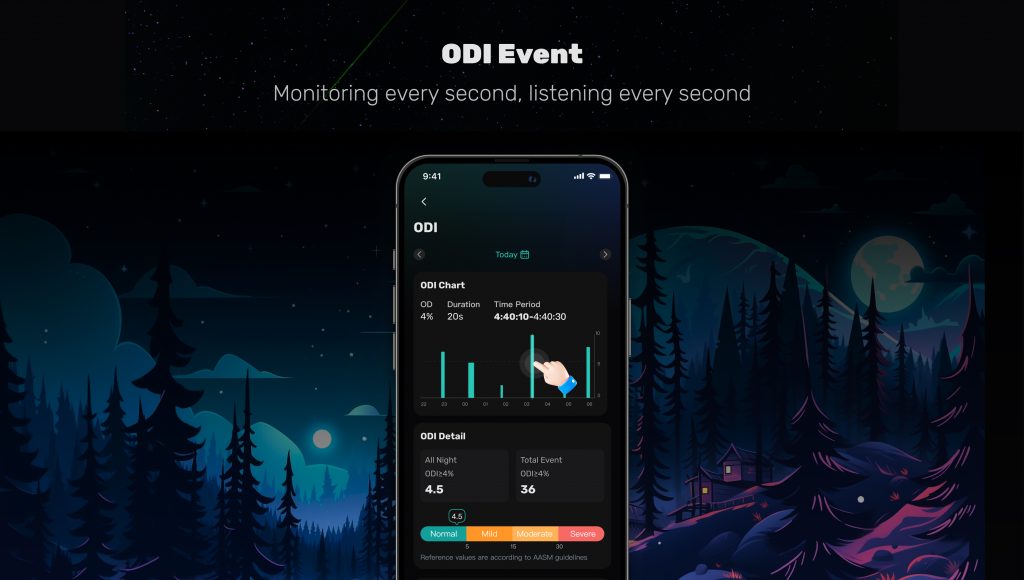#SLEEPON APP 3.0 Feature Sharing# – ODI
According to research, 1 billion adults worldwide suffer from sleep apnea , and one in every five snorers suffers from obstructive sleep apnea and is deeply affected by it, but only a small number of people receive clinical diagnosis. There are many reasons, among which the traditional “complex” monitoring equipment is not easy to popularize and apply, which highlights the important value and significance of portable screening instruments (such as Go2sleep ) for the clinical evaluation and treatment of sleep apnea.
If sleep apnea is not taken seriously, it often causes systemic damage such as hypertension, diabetes, emotional changes, and can also affect pregnant women and fetuses, and even cause greater risks such as sudden death. Faced with sleep apnea, experts say that early diagnosis and treatment are the key. ODI is usually related to sleep apnea, especially sleep apnea.
What is ODI? The connection between ODI and OSA
The Oxygen Desaturation Index (ODI) is an indicator used to measure the decrease in oxygen saturation during sleep. It is calculated by calculating the number of times the blood oxygen level drops by a certain percentage from the base line per hour during sleep. It is usually used as an indicator of the severity of sleep apnea. Higher ODI values usually indicate more severe sleep apnea. Clinicians usually use ODI and other sleep research data to evaluate the necessity of intervention and guide treatment decisions.
Obesity-induced upper respiratory tract narrowing, alcohol and sedative use, smoking, and aging can all lead to poor ODI, which can have various health consequences such as hypertension, cardiovascular disease, OSA, daytime sleepiness and fatigue, memory and cognitive dysfunction, increased risk of insulin resistance and type 2 diabetes, weight gain, depression and anxiety, motor vehicle accidents, and reduced quality of life.
The Oxygen Desaturation Index (ODI) can provide information about physical functional conditions, especially sleep-related apnea symptoms. Different ODI manifestations may indicate different physical functional conditions, especially in cases related to sleep apnea. The following are some common ODI manifestations and their possible indications of physical functional conditions.
-
Low ODI (close to zero):
Normal respiratory function : Low ODI values usually indicate normal respiratory function during sleep, with no significant oxygen saturation decrease events. -
Medium ODI (5-15 events/hour):
Mild sleep apnea : Moderate ODI values may indicate the presence of mild sleep apnea. This may be associated with partial obstructive sleep apnea syndrome (OSA). -
Higher ODI (15-30 events/hour):
Moderate sleep apnea : Higher ODI values may indicate moderate severity of sleep apnea. This may cause more frequent drops in oxygen saturation, which may lead to some health problems. -
Very high ODI (30 events/hour or more):
Severe sleep apnea : Very high ODI values may indicate severe sleep apnea, which may be accompanied by a significant decrease in oxygen saturation. This may cause more serious health problems such as high blood pressure, heart disease, etc. - Changes in ODI and treatment response:
Monitoring of treatment effects: For people with sleep apnea, changes in ODI can be used to monitor treatment effects . Effective treatment may result in a decrease in ODI, indicating a decrease in apnea events.

SLEEPON 3.0 Upgrades Your Sleep Detection Experience – ODI
Due to the concern for healthy sleep, in the upgraded development of SLEEPON 3.0, we have changed the inconvenient detection method of traditional polysomnography and innovatively invented the wearable and detectable home sleep detection ring Go2sleep. Our home sleep tracking ring Go2sleep has been retrofitted with ODI and enhanced by algorithms, tracking sleep data from hours to seconds, greatly improving the accuracy and reliability of the data.

Go2sleep 3.0 Upgrade: Your Voice Matters!

Dear members of the Go2sleep community, Go2sleep will usher in a major upgrade – Go2sleep 3.0! At this important moment, we are eager to hear your voice, understand your expectations and suggestions.
- Customized experience : Your feedback will help us better understand your needs and provide you with a more personalized sleep experience.
- Technology enhancements : We want to hear your thoughts on new features, improvements and innovations to ensure Go2sleep 3.0 meets your expectations.
- Community building : By sharing your opinions, you will become a key member in shaping the future of Go2sleep and build a community with us.
Share your suggestions in the comment section:
We invite you to leave your suggestions, expectations, or any thoughts about Go2sleep 3.0 in the comments section. You can talk about your most anticipated features, expectations for upgrades, or your personal sleep experience.
For more news about the 3.0 APP upgrade, you can subscribe and follow us.











How do I upgrade my GoToSleep ring to 3.0? I just received a ring and it is 2.0 and isn’t functioning very well in spite of following all directions correctly
Susan Cologne on